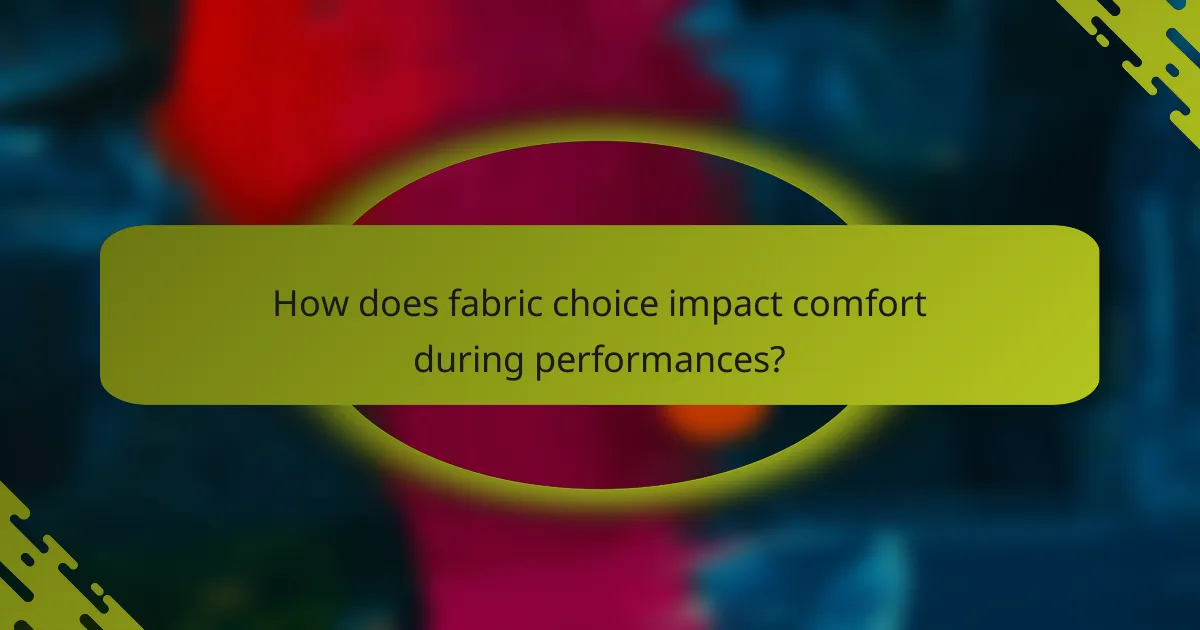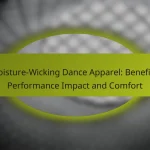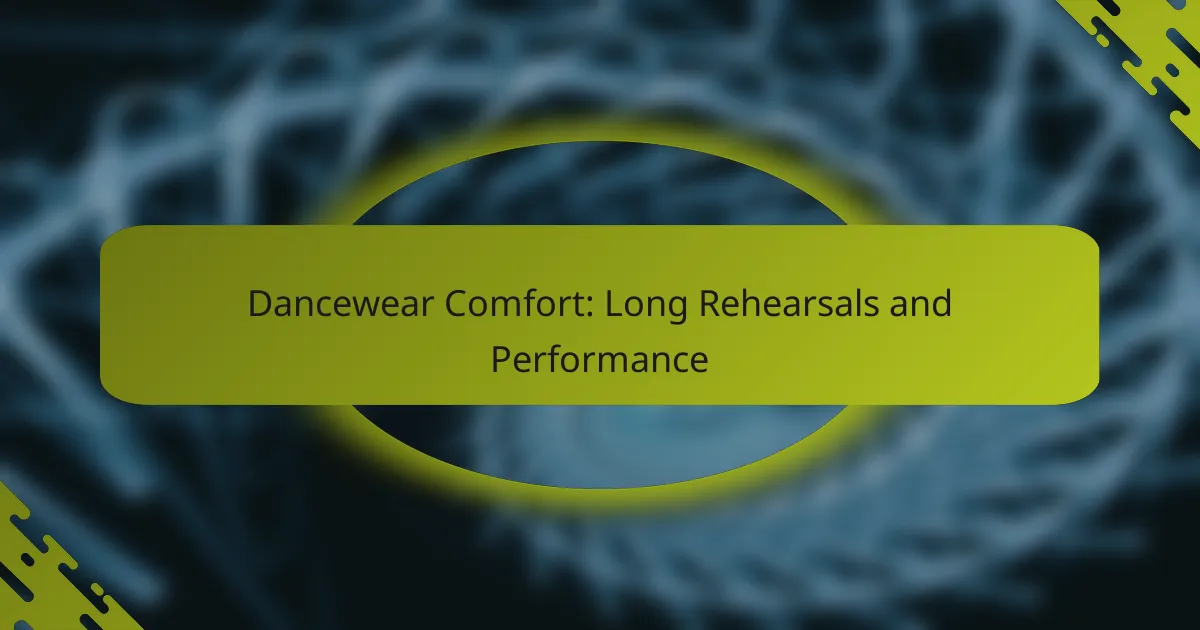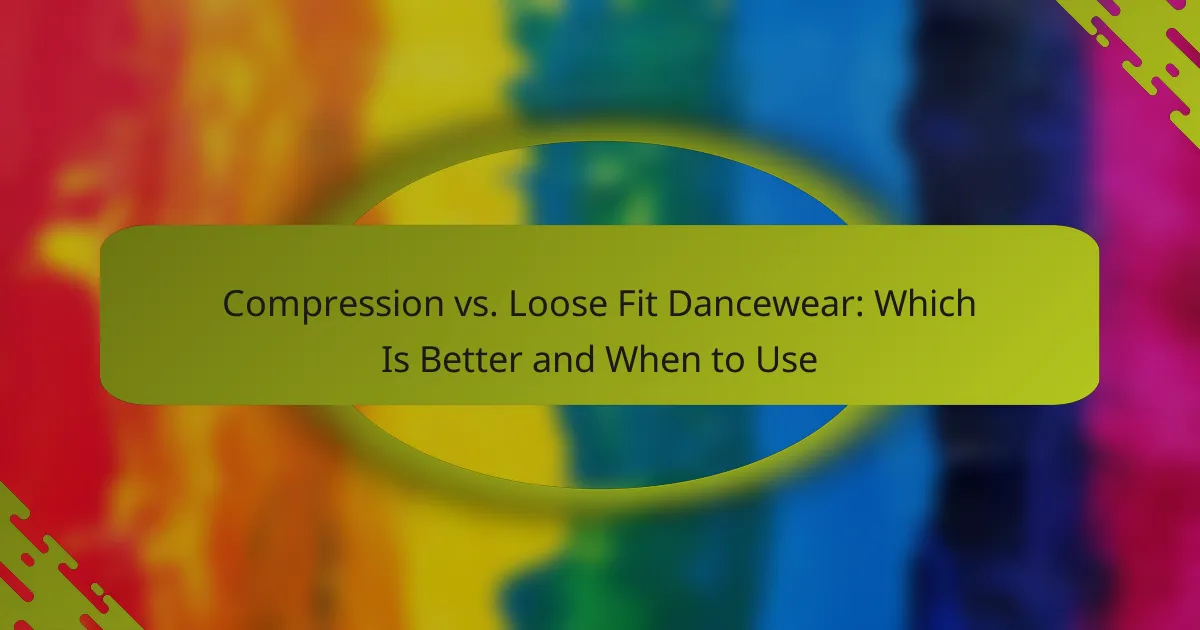Choosing the right dancewear is crucial for ensuring comfort during long rehearsals and performances. Prioritizing features such as flexibility, breathability, and seamless construction can significantly enhance a dancer’s experience, allowing them to focus on their movements without distraction. The right fabric and fit not only improve mobility but also help regulate body temperature, making them essential for optimal performance.

What are the best dancewear options for long rehearsals?
The best dancewear options for long rehearsals prioritize comfort, flexibility, and breathability. Choosing the right attire can enhance performance and reduce fatigue, allowing dancers to focus on their movements without distraction.
High-performance leggings
High-performance leggings are essential for long rehearsals as they provide support and flexibility. Look for leggings made from stretchy, breathable fabrics that allow for a full range of motion while wicking away sweat.
Consider options with a high waistband for added support and pockets for convenience. Brands often offer leggings with varying thicknesses, so choose a pair that suits the rehearsal environment, whether it’s a warm studio or a cooler space.
Breathable leotards
Breathable leotards are a staple in dancewear, especially for extended practice sessions. They should be made from lightweight, moisture-wicking materials that keep dancers cool and comfortable.
Opt for styles with adjustable straps or varying necklines to suit personal preferences and body types. A well-fitted leotard can enhance movement and provide the necessary support during rigorous routines.
Moisture-wicking tops
Moisture-wicking tops are crucial for managing sweat during long rehearsals. These tops help regulate body temperature and keep dancers dry, allowing them to concentrate on their performance.
Choose tops with breathable fabrics and consider layering options, such as short-sleeve or long-sleeve styles, to adapt to different rehearsal conditions. A loose fit can also enhance comfort and airflow.
Supportive dance bras
Supportive dance bras are vital for providing comfort during intense movement. Look for bras designed specifically for dance, offering both support and flexibility without restricting movement.
Consider options with adjustable straps and varying levels of support based on the type of dance being performed. A well-fitted dance bra can prevent discomfort and distractions during long sessions.
Comfortable warm-up layers
Comfortable warm-up layers are important for preparing the body before rehearsals. These layers should be easy to put on and take off, allowing dancers to transition smoothly into their routines.
Choose lightweight, stretchy fabrics that provide warmth without overheating. Options like wrap sweaters or joggers can be ideal for keeping muscles warm and preventing injuries during warm-ups and cool-downs.

How does fabric choice impact comfort during performances?
Fabric choice significantly affects comfort during performances by influencing how dancers move, regulate body temperature, and withstand wear. Selecting the right materials can enhance performance quality and overall experience, especially during long rehearsals or shows.
Stretchability for movement
Stretchable fabrics allow dancers to move freely without restrictions, which is crucial for executing various dance styles. Look for materials like spandex or lycra blended with cotton or polyester, as they provide the necessary elasticity while maintaining shape. A good rule of thumb is to choose fabrics that can stretch at least 20-30% beyond their original size.
When trying on dancewear, ensure that it fits snugly but comfortably, allowing for a full range of motion. Avoid overly tight options that can restrict movement or cause discomfort during extended performances.
Breathability for temperature regulation
Breathable fabrics help regulate body temperature by allowing moisture to escape, which is essential during intense physical activity. Natural fibers like cotton or moisture-wicking synthetics such as polyester are excellent choices for keeping dancers cool and dry. Fabrics that dry quickly can also enhance comfort during long rehearsals.
To assess breathability, check for mesh panels or lightweight weaves in the fabric. If possible, test the fabric by wearing it during a warm-up to see how well it manages heat and moisture.
Durability for repeated use
Durability is vital for dancewear, especially for those who perform frequently. Fabrics should withstand the rigors of practice and performances without losing shape or comfort. Look for materials that are resistant to pilling, fading, and stretching out over time.
Consider investing in higher-quality fabrics that may have a higher upfront cost but will last longer, saving money in the long run. Regularly inspect your dancewear for signs of wear and replace items that show significant damage to maintain performance quality.

What features should dancewear have for optimal comfort?
For optimal comfort during long rehearsals and performances, dancewear should incorporate seamless construction, adjustable fits, and non-restrictive designs. These features enhance mobility, reduce irritation, and allow for a personalized fit, making them essential for any dancer.
Seamless construction
Seamless construction in dancewear minimizes friction against the skin, which is crucial during extended periods of movement. This design reduces the risk of chafing and irritation, allowing dancers to focus on their performance rather than discomfort.
When selecting seamless garments, look for options made from stretchy, breathable materials that conform to the body. Brands often use advanced knitting techniques to create these seamless styles, which can significantly enhance overall comfort.
Adjustable fits
Adjustable fits are vital for accommodating different body shapes and sizes, ensuring that dancewear remains comfortable throughout long sessions. Features like drawstrings, adjustable straps, or elastic waistbands allow dancers to customize their fit for maximum comfort.
When choosing adjustable dancewear, consider how easily the adjustments can be made. Quick-release mechanisms or simple ties can make a significant difference in convenience, especially during quick costume changes or transitions between rehearsals and performances.
Non-restrictive designs
Non-restrictive designs allow for a full range of motion, which is essential for executing dance movements effectively. Look for styles that feature wide armholes, relaxed fits, or strategically placed cutouts that enhance mobility without compromising support.
Additionally, fabrics that offer four-way stretch can significantly improve comfort by allowing the garment to move with the dancer’s body. This flexibility is particularly important for styles that require dynamic movements, such as ballet or contemporary dance.

How can dancers ensure proper fit for their dancewear?
Dancers can ensure proper fit for their dancewear by accurately measuring their body dimensions, consulting size charts, and trying on different brands. A well-fitting outfit enhances comfort and performance during long rehearsals and performances.
Measuring body dimensions
To achieve the best fit, dancers should take accurate measurements of their body dimensions. Key measurements include bust, waist, hips, inseam, and torso length. Using a flexible measuring tape, it’s advisable to measure while wearing minimal clothing to get precise results.
Consider measuring at different times of the day, as body dimensions can fluctuate. It’s also helpful to have someone assist with the measurements to ensure accuracy, especially for hard-to-reach areas.
Consulting size charts
Once measurements are taken, dancers should consult the size charts provided by dancewear brands. Size charts typically correlate measurements to specific sizes, helping to identify the best fit. Keep in mind that sizing can vary significantly between brands.
It’s beneficial to look for brands that provide detailed size charts and guidelines. If in between sizes, consider the type of fit desired; a tighter fit may require choosing the smaller size, while a looser fit may call for the larger size.
Trying on different brands
Trying on dancewear from various brands is crucial, as fit and comfort can differ widely. Each brand may have unique sizing and cut, which can affect how the garment feels during movement. Dancers should prioritize comfort and flexibility when trying on outfits.
When trying on dancewear, perform a few movements such as pliés or turns to assess comfort and range of motion. If possible, wear the outfit for a short period to ensure it remains comfortable over time, especially during long rehearsals or performances.

What are the top brands for comfortable dancewear?
The top brands for comfortable dancewear include Bloch, Capezio, Gaynor Minden, and Wear Moi. These brands are known for their high-quality materials, innovative designs, and focus on dancer comfort, making them ideal choices for long rehearsals and performances.
Bloch
Bloch is renowned for its extensive range of dancewear that prioritizes comfort and functionality. Their products often feature breathable fabrics and ergonomic designs that support movement, making them suitable for various dance styles.
When choosing Bloch, consider their sizing options and the specific needs of your dance discipline. Many dancers appreciate their ballet shoes and leotards for their snug fit and durability, which can withstand rigorous training sessions.
Capezio
Capezio has been a staple in the dancewear industry for decades, offering a wide selection of comfortable apparel. Their garments are designed with both performance and comfort in mind, often incorporating moisture-wicking materials to keep dancers dry during long rehearsals.
Look for Capezio’s signature styles, such as their tights and leotards, which are popular among dancers for their flattering cuts and range of colors. Their products are generally well-reviewed for fit and longevity, making them a reliable choice.
Gaynor Minden
Gaynor Minden is particularly noted for its innovative approach to ballet shoes, combining comfort with advanced technology. Their shoes feature a unique design that allows for flexibility while providing necessary support, which is crucial for long hours of practice.
When selecting Gaynor Minden, pay attention to their custom fitting options, which can enhance comfort and performance. Many dancers find that their shoes reduce foot fatigue, making them ideal for extended use.
Wear Moi
Wear Moi is celebrated for its stylish yet comfortable dancewear that caters to both classical and contemporary dancers. Their collections often blend fashion with functionality, ensuring that dancers feel good while performing.
Consider Wear Moi for their high-quality fabrics and attention to detail, which contribute to the overall comfort of their garments. Their leotards and skirts are particularly favored for their elegant designs and comfortable fits, making them a great addition to any dancer’s wardrobe.










